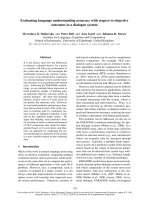Adding Swap File Space in a Linux System
Bạn đang xem bản rút gọn của tài liệu. Xem và tải ngay bản đầy đủ của tài liệu tại đây (9.32 KB, 2 trang )
1 - 2 IT Essentials II v2.0 - Lab 7.2.6 Copyright 2002, Cisco Systems, Inc.
Lab 7.2.6: Adding Swap File Space in a Linux System
Estimated Time: 20 minutes
Objective
To assess and add swap space in a Linux Red Hat operating system.
Equipment
• A computer with Linux Red Hat 7.X installed
Scenario
The system administrator of a large company notices that one of the Linux Apache Web
servers for the internal company Web site has been running slowly, and most of its
resources have been used up. Most of the IT budget for the year has been spent.
Therefore, adding more RAM is not an option. The administrator decides to add more
swap space to the server instead.
Procedures
Step 1: Assessing swap usage
In order to determine how much swap space to add, first look at the size of some files on
the system. Determine how much memory is being used and how much is left on the
system.
The free command in Linux can be used to check the system memory. Type free –m
–t at the shell prompt.
How much physical memory is available? How much physical memory is being used?
__________________________________________________________________
__________________________________________________________________
__________________________________________________________________
__________________________________________________________________
__________________________________________________________________
2 - 2 IT Essentials II v2.0 - Lab 7.2.6 Copyright 2002, Cisco Systems, Inc.
Step 2: Adding a swap file
To add swap space on a system, add a swap file by using the following steps:
1. Create a file that is equal in size to the swap file that is going to be created. Do this
by using the dd command. Enter the following command at the shell prompt:
dd if=/dev/zero of=swap.swp bs=1024 count=131072
2. The swap.swp file that was created will need to be initialized. When it is initialized,
the Linux system can use it to swap memory to a disk. Use the mkswap command to
enable Linux to use the new swap file. However, the new swap file will not be active.
Enter the following command at the shell prompt:
mkswap –f /root/swap.swp
or type
/sbin/mkswap –f /root/swap.swp
3. To activate this swap file, use the swapon command. To make this swap file inactive,
use the swapoff command in place of the swapon command. Enter the following
command at the shell prompt:
swapon /root/swap.swp
or type
/sbin/swapon /root/swap.swp
The swap file that was just created will not be used the next time the system is rebooted
unless the entry in made in /etc/fstab.
Reflection
This method is the quickest and easiest way to add swap space. However, it does create
some problems. By creating this swap file on a partition that is already being used, the
file can become fragmented as the partition gets used more and more. What are some
other methods that can be used to add a swap file?









